Characterization of a Patch Antenna Sensor’s Resonant Frequency Response in Identifying the Notch-Shaped Cracks on Metal Structure
Abstract
:1. Introduction
2. Principle of Operation
2.1. Crack Detection Mechanism of Patch Antenna Sensor
2.2. Analytical Expression of Antenna Sensor’s Current Distribution
3. Sensor Design and Simulation
3.1. Sensor Design Parameters
3.2. Simulation Model
3.3. Simulated Results
4. Algorithm for Predicting the Crack-Caused Resonant Frequency Shifts
4.1. Definition of the Current Cutting Effect Coefficient
4.2. Relationship between Resonant Frequency Shift and Coefficient
4.3. Process of the Algorithm
5. Experimental Validation
5.1. Sensor Fabrication and Experiment Setup
5.2. Experiment Results
5.3. Case Study—Validation of the Proposed Algorithm
6. Conclusions
Author Contributions
Funding
Acknowledgments
Conflicts of Interest
References
- Chee-Hoe, F.; Marian, W.; William, F.D. Novel dynamic fatigue-testing device: Design and measurements. Meas. Sci. Technol. 2006, 17, 2218. [Google Scholar] [CrossRef]
- Yan, Y.J.; Cheng, L.; Wu, Z.Y.; Yam, L.H. Development in vibration-based structural damage detection technique. Mech. Syst. Signal Proc. 2007, 21, 2198–2211. [Google Scholar] [CrossRef]
- Jassim, Z.A.; Ali, N.N.; Mustapha, F.; Abdul Jalil, N.A. A review on the vibration analysis for a damage occurrence of a cantilever beam. Eng. Fail. Anal. 2013, 31, 442–461. [Google Scholar] [CrossRef]
- Liu, X.J.; Qing-Xu, Y.U. Experimental study of distributed optical fiber sensor for crack detection. J. Optoelectron. Laser 2005, 16, 779–782. [Google Scholar]
- Ravet, F.; Briffod, F.; Glisic, B.; Nikles, M.; Inaudi, D. Submillimeter crack detection with brillouin-based fiber-optic sensors. IEEE Sens. J. 2009, 9, 1391–1396. [Google Scholar] [CrossRef]
- Glisic, B.; Inaudi, D. Development of method for in-service crack detection based on distributed fiber optic sensors. Struct. Health Monit. 2012, 11, 161–171. [Google Scholar] [CrossRef]
- Tian, G.Y.; Sophian, A.; Taylor, D.; Rudlin, J. Multiple sensors on pulsed eddy-current detection for 3-D subsurface crack assessment. IEEE Sens. J. 2005, 5, 90–96. [Google Scholar] [CrossRef]
- Hughes, R.R.; Dixon, S. Eddy-current crack detection at frequencies approaching electrical resonance. AIP Conf. Proc. 2014, 1581, 1366–1373. [Google Scholar] [CrossRef]
- Zhang, W.; Wu, W.; Sun, X.; Xiao, L.; Qu, W. Damage Detection of closed crack in a metallic plate using nonlinear ultrasonic time reversal method. J. Sens. 2013, 2013, 10. [Google Scholar] [CrossRef]
- Sohn, H.; Lim, H.J.; DeSimio, M.P.; Brown, K.; Derriso, M. Nonlinear ultrasonic wave modulation for online fatigue crack detection. J. Sound Vib. 2014, 333, 1473–1484. [Google Scholar] [CrossRef]
- Glushkov, Y.V.; Glushkova, N.V.; Yekhlakov, A.V. A mathematical model of the ultrasonic detection of three-dimensional cracks. J. App. Math. Mech. 2002, 66, 141–149. [Google Scholar] [CrossRef]
- Chia, C.C.; Lee, J.-R.; Bang, H.-J. Structural health monitoring for a wind turbine system: A review of damage detection method. Meas. Sci. Technol. 2008, 19, 122001. [Google Scholar]
- Nair, A.; Cai, C.S. Acoustic emission monitoring of bridges: Review and case studies. Eng. Struct. 2010, 32, 1704–1714. [Google Scholar] [CrossRef]
- Li, X.; Liu, Z.; Jiang, X.; Lodewijks, G. Method for detecting damage in carbon-fibre reinforced plastic-steel structures based on eddy current pulsed thermography. Nondestruct. Test. Eval. 2018, 33, 1–19. [Google Scholar] [CrossRef]
- Liu, Z.; Fang, G.; Jiang, L.; Jiang, X.; Lodewijks, G. Design and experimental study of a novel excitation coil based on pulsed eddy current thermography. Insight Nondestruct. Test. Cond. Monit. 2017, 59, 491–499. [Google Scholar]
- Deshmukh, S.; Mohammad, I.; Tentzeris, M.; Wu, T.; Huang, H. Crack detection and monitoring using passive wireless sensor. In Proceedings of the ASME 2009 Conference on Smart Materials, Adaptive Structures and Intelligent Systems, Oxnard, CA, USA, 21–23 September 2009. [Google Scholar]
- Mohammad, I.; Huang, H. An antenna sensor for crack detection and monitoring. Adv. Struct. Eng. 2011, 14, 47–53. [Google Scholar] [CrossRef]
- Mohammad, I.; Huang, H. Monitoring fatigue crack growth and opening using antenna sensors. Smart Mater. Struct. 2010, 19, 055023. [Google Scholar] [CrossRef]
- Xu, X.; Huang, H. Multiplexing passive wireless antenna sensors for multi-site crack detection and monitoring. Smart Mater. Struct. 2012, 21, 015004. [Google Scholar] [CrossRef]
- Deshmukh, S.; Huang, H. Wireless interrogation of passive antenna sensors. Meas. Sci. Technol. 2010, 21, 035201. [Google Scholar] [CrossRef]
- Yi, X.; Cho, C.; Fang, C.; Cooper, J.; Lakafosis, V.; Vyas, R.; Wang, Y.; Leon, R.T.; Tentzeris, M.M. Wireless strain and crack sensing using a folded patch antenna. Proceedings of 6th European Conference on Antennas and Propagation (EUCAP 2012), Prague, Czech Republic, 26–30 March 2012; pp. 1678–1681. [Google Scholar]
- Yi, X.; Cho, C.; Cooper, J.; Wang, Y.; Tentzeris, M.M.; Leon, R. T Passive wireless antenna sensor for strain and crack sensing—Electromagnetic modeling, simulation, and testing. Smart Mater. Struct. 2013, 22, 085009. [Google Scholar] [CrossRef]
- Cook, B.S.; Shamim, A.; Tentzeris, M.M. Passive low-cost inkjet-printed smart skin sensor for structural health monitoring. IET Microw. Antennas Propag. 2013, 6, 1536–1541. [Google Scholar] [CrossRef]
- Cho, C.; Yi, X.; Li, D.; Wang, Y.; Tentzeris, M.M. Passive wireless frequency doubling antenna sensor for strain and crack sensing. IEEE Sens. J. 2016, 16, 5725–5733. [Google Scholar] [CrossRef]
- Zhang, J.; Huang, B.; Zhang, G.; Yun Tian, G. Wireless passive ultra high frequency RFID antenna sensor for surface crack monitoring and quantitative analysis. Sensors 2018, 18, 2130. [Google Scholar] [CrossRef] [PubMed]
- Mohammad, I.; Gowda, V.; Zhai, H.; Huang, H. Detecting crack orientation using antenna sensors. Meas. Sci. Technol. 2011, 7981, 765–768. [Google Scholar] [CrossRef]
- Balanis, C. Antenna Theory: Analysis and Design; John Wiley and Sons: New York, NY, USA, 2005; Volume 1. [Google Scholar]
- Ghosh, D.K.; Ghosh, S.; Chattopadhyay, S.; Nandi, S.; Chakraborty, D.; Anand, R.; Raj, R.; Ghosh, A. Physical and quantitative analysis of compact rectangular microstrip antenna with shorted non-radiating edges for reduced cross-polarized radiation using modifi ed cavity model. IEEE Antennas Propag. Mag. 2014, 56, 61–72. [Google Scholar] [CrossRef]
- Barkeshli, K.; Volakis, J.L. Electromagnetic scattering from thin strips. I. Analytical solutions for wide and narrow strips. IEEE Trans. Educ. 2004, 47, 100–106. [Google Scholar] [CrossRef]
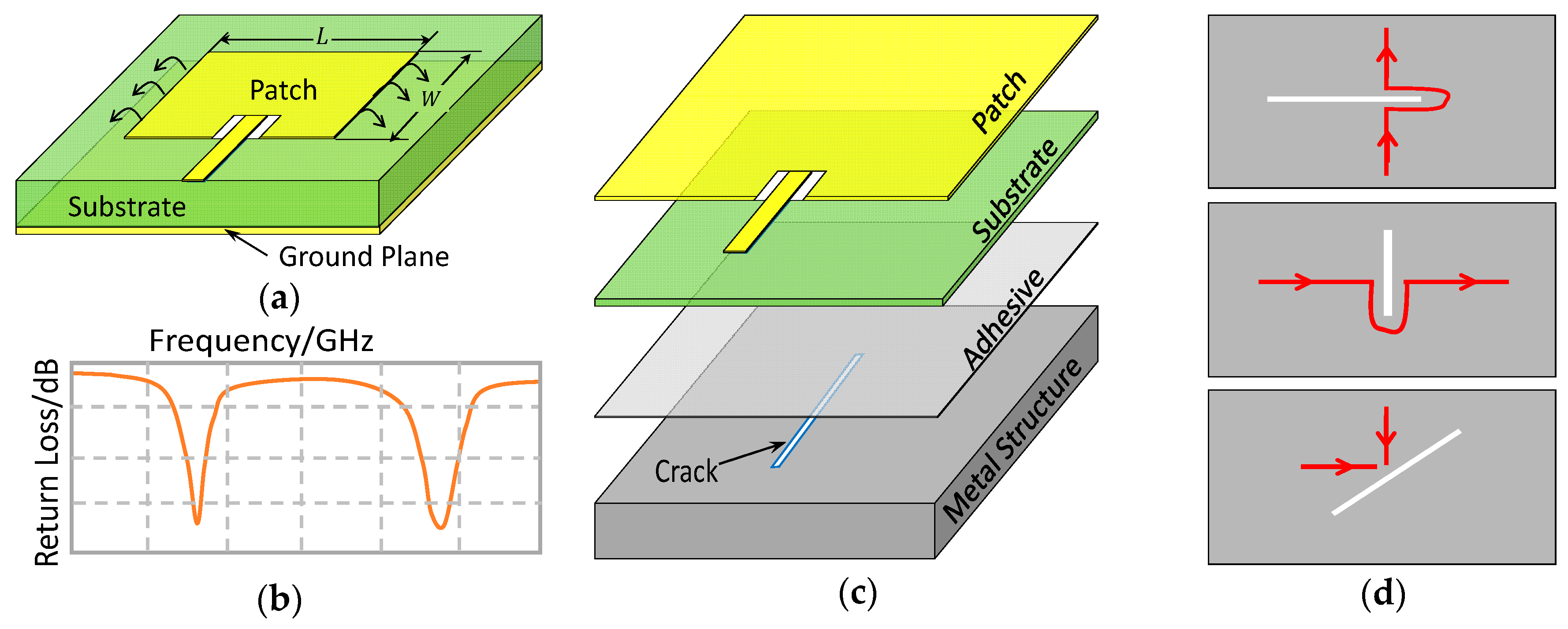





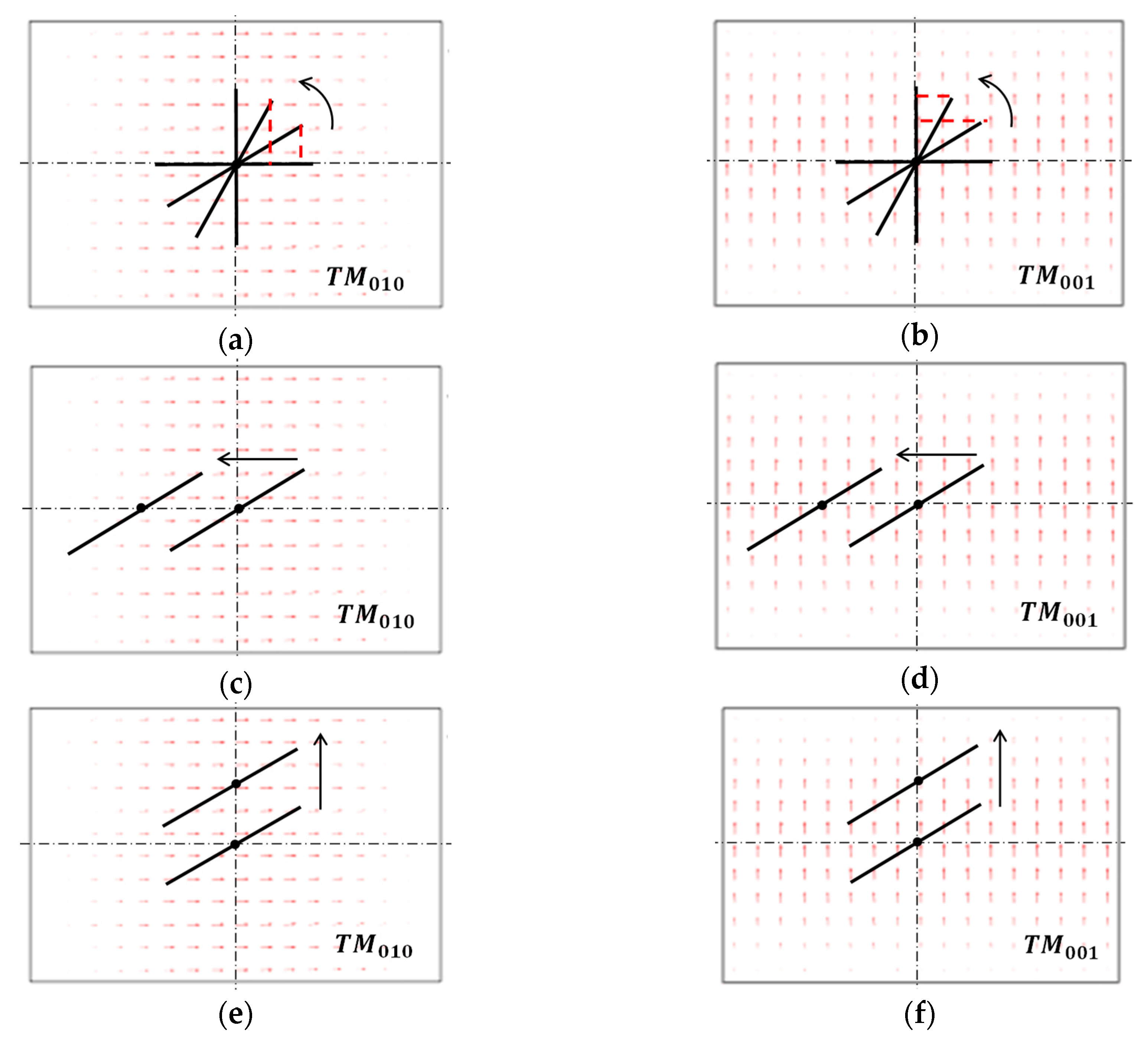
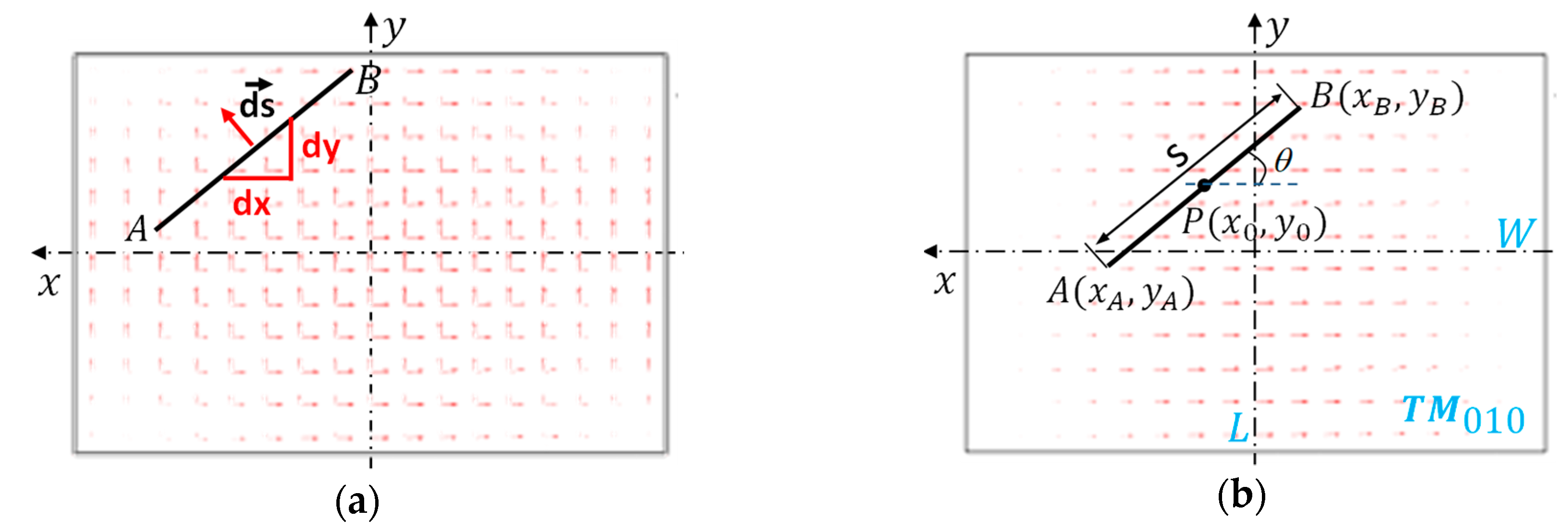
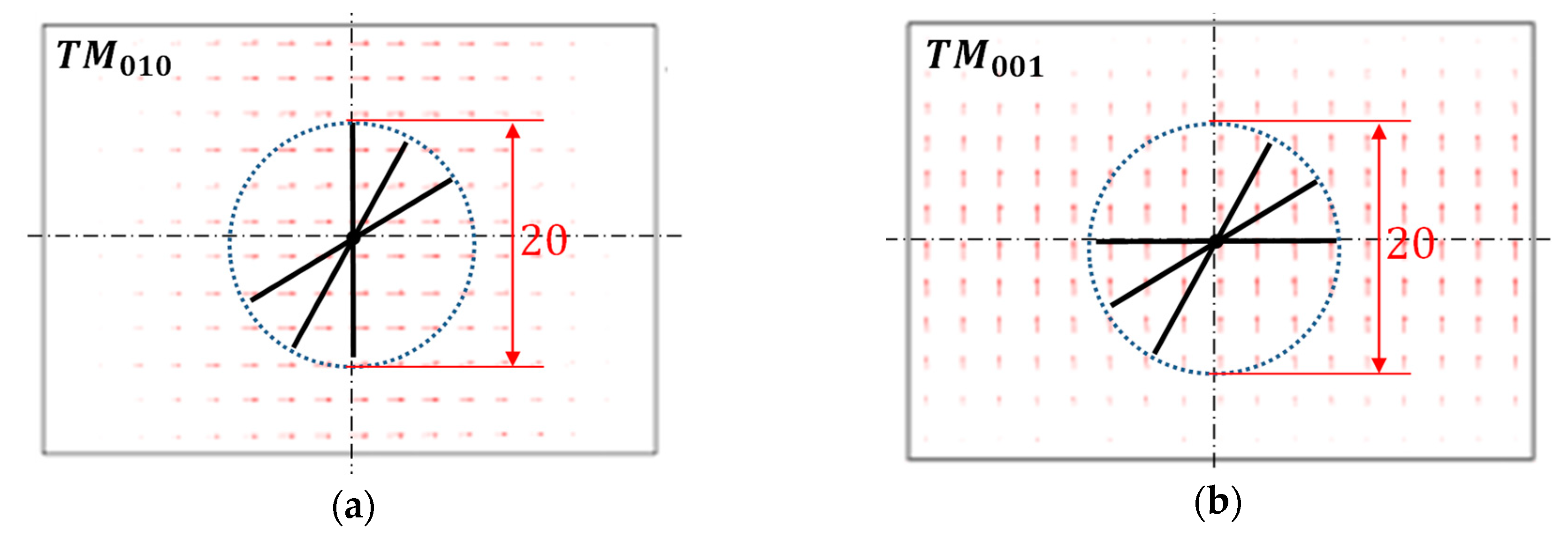
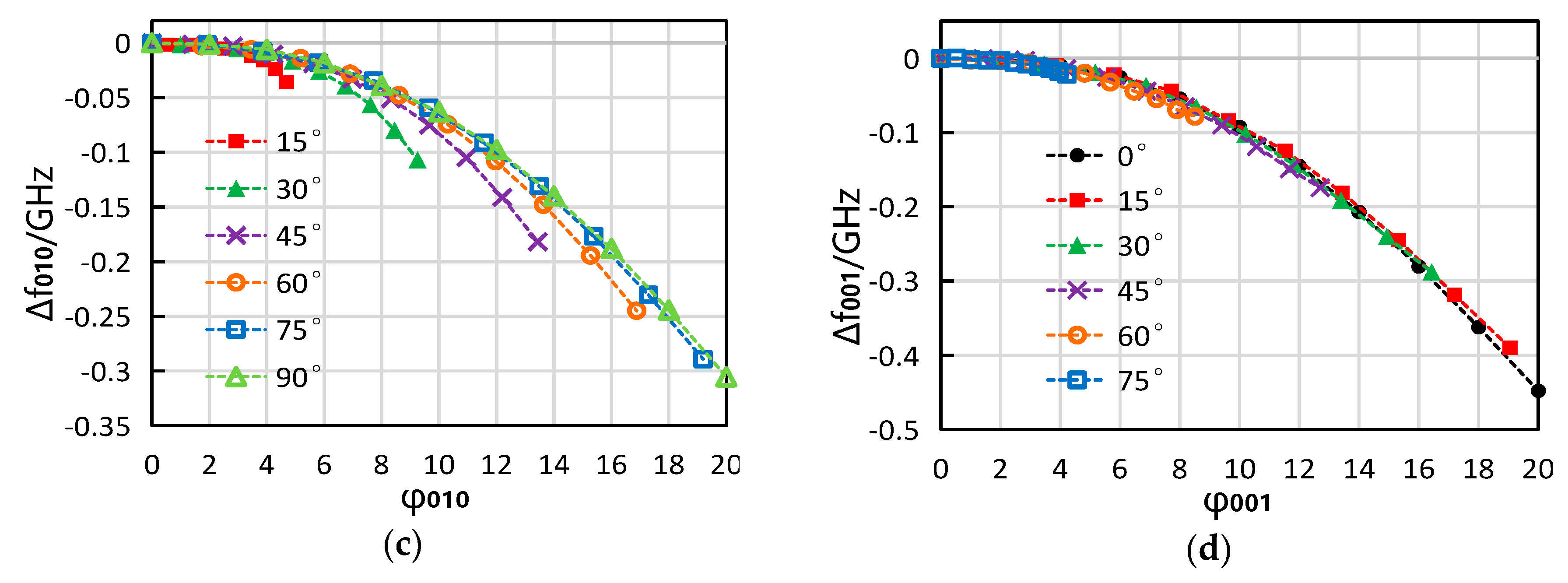
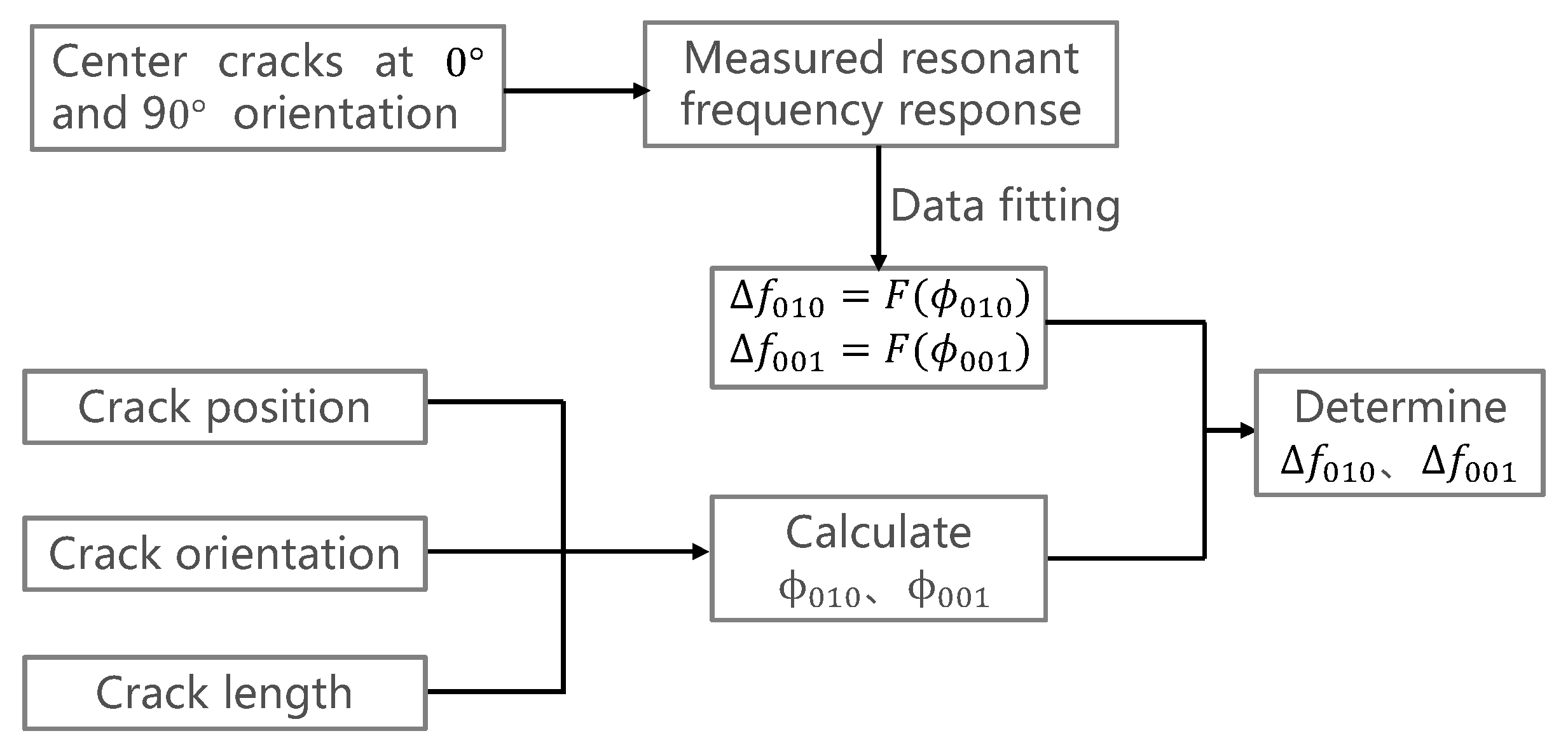

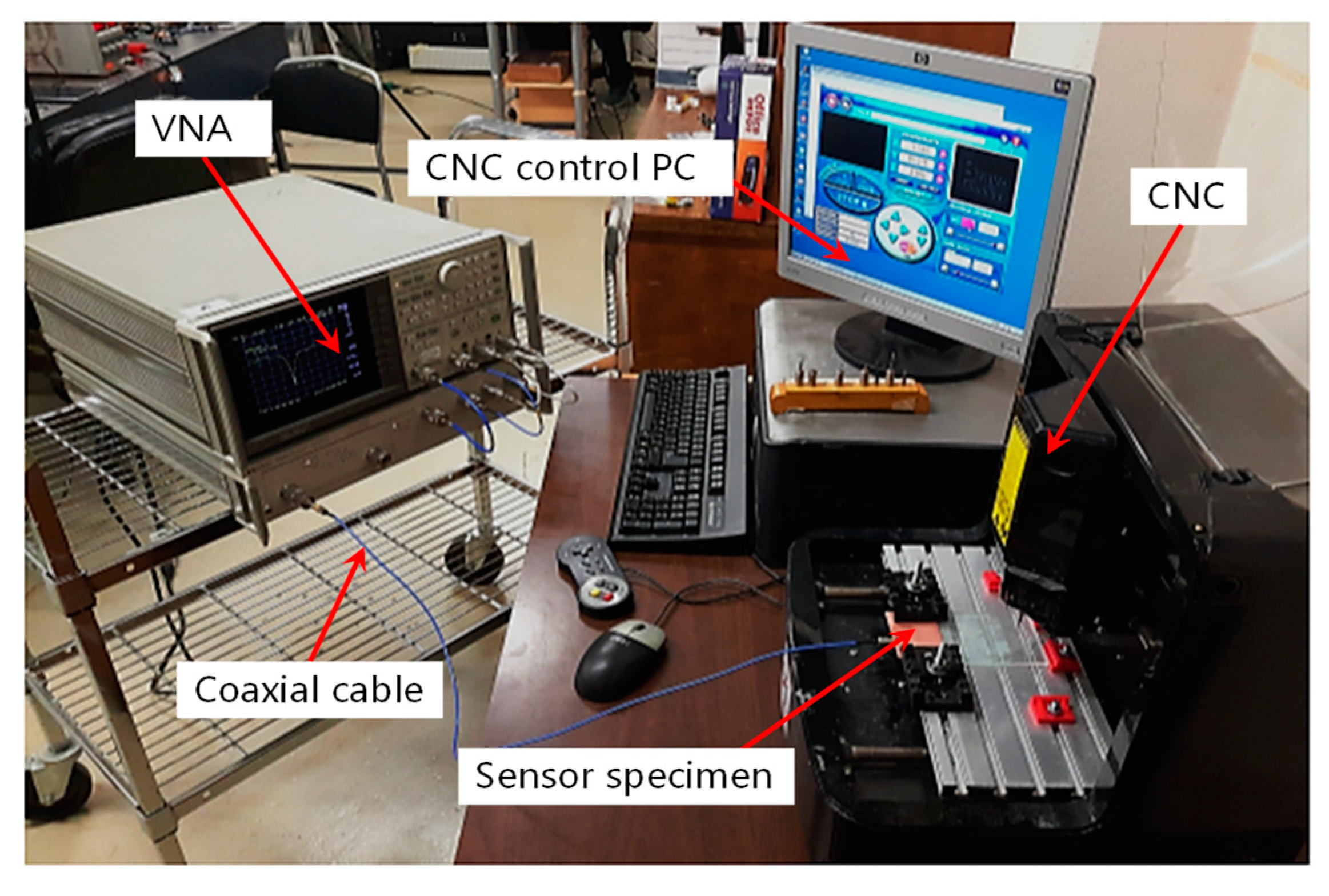

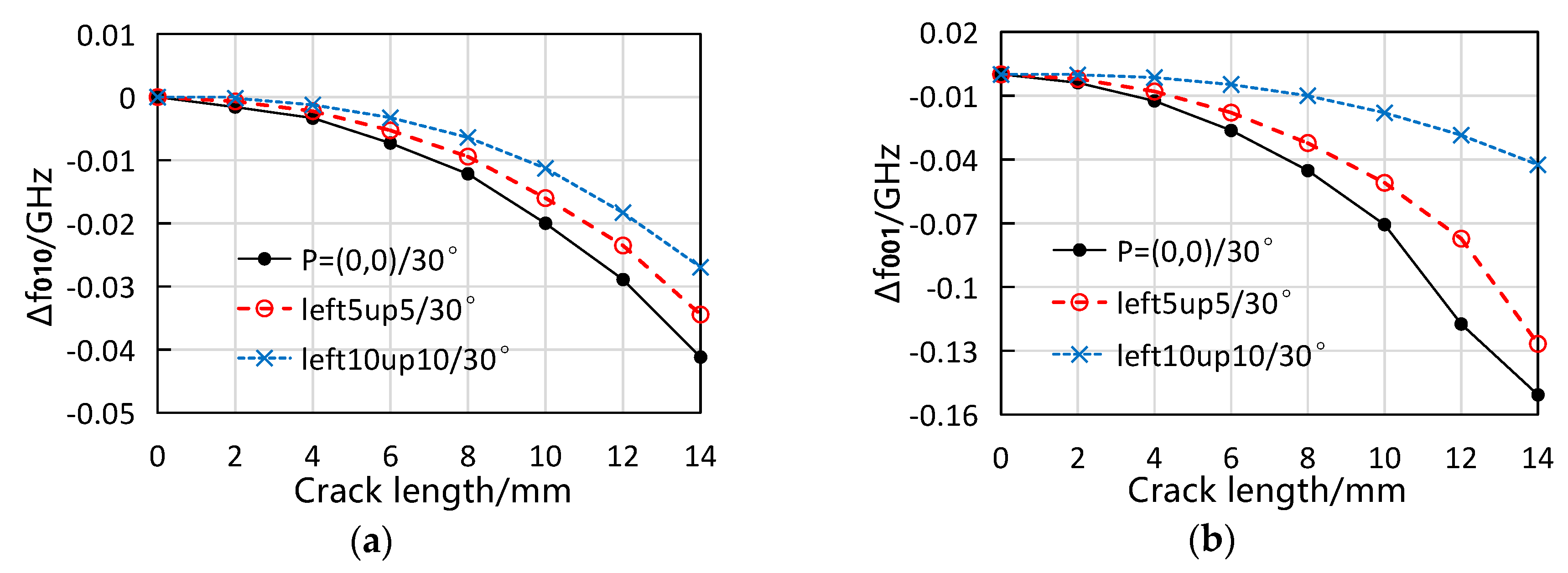
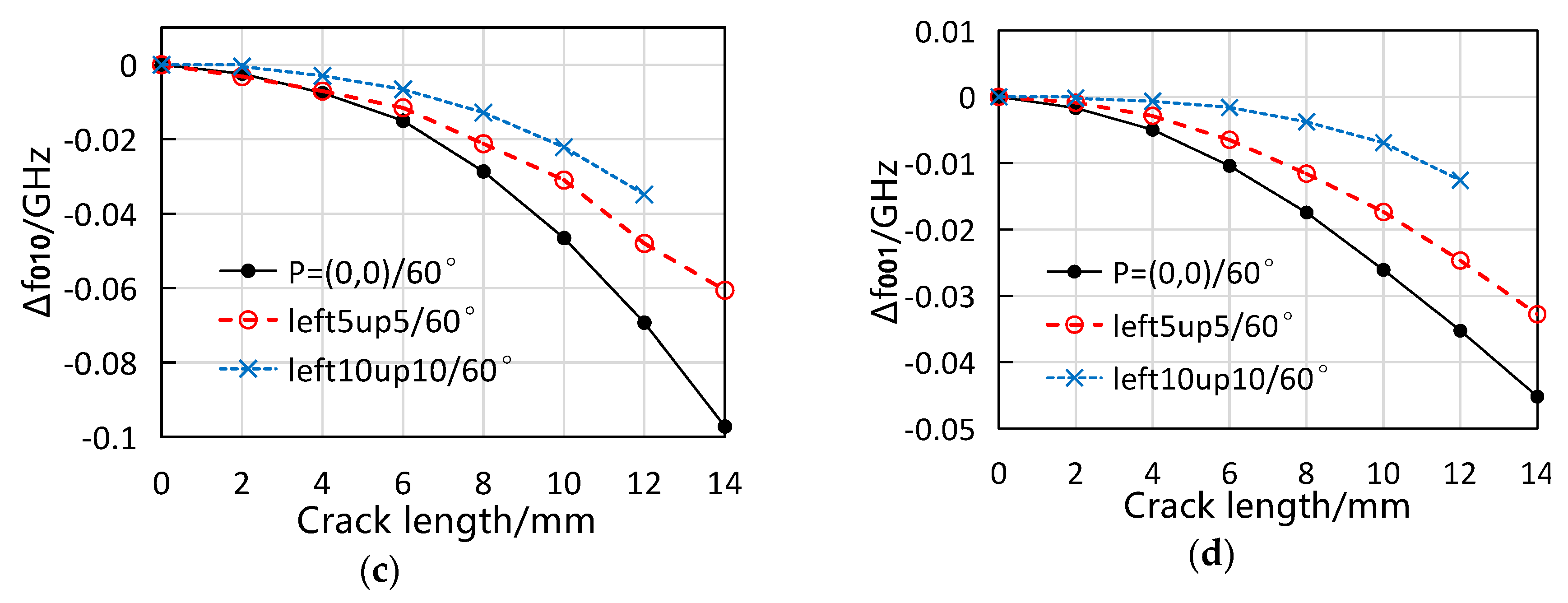
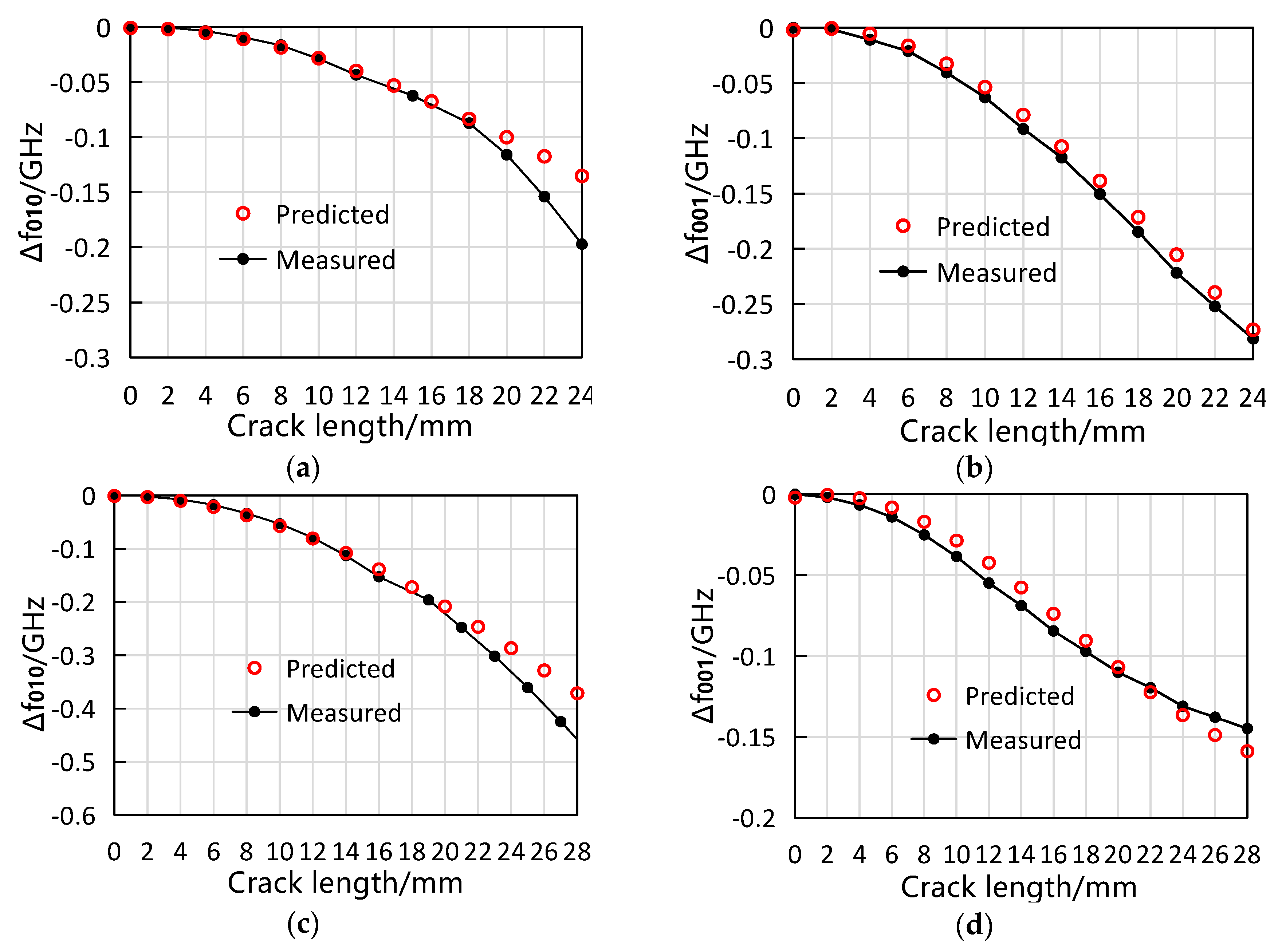
| Symbol | Physical Quantity | Selected Value |
|---|---|---|
| , | Designed initial resonant frequencies | 1.80 GHz, 2.54 GHz |
| Substrate dielectric constant | 4.4 | |
| Substrate thickness | 0.5 mm | |
| Radiation patch length | 40 mm | |
| Radiation patch width | 28 mm | |
| Transmission line width | 1 mm | |
| Transmission line position | 29.5 mm | |
| Length of substrate/ground plane | 64 mm | |
| Width of substrate/ground plane | 44 mm | |
| Horizontal distance from patch edge to substrate edge | 12 mm | |
| Vertical distance from patch edge to substrate edge | 8 mm |
© 2018 by the authors. Licensee MDPI, Basel, Switzerland. This article is an open access article distributed under the terms and conditions of the Creative Commons Attribution (CC BY) license (http://creativecommons.org/licenses/by/4.0/).
Share and Cite
Ke, L.; Liu, Z.; Yu, H. Characterization of a Patch Antenna Sensor’s Resonant Frequency Response in Identifying the Notch-Shaped Cracks on Metal Structure. Sensors 2019, 19, 110. https://doi.org/10.3390/s19010110
Ke L, Liu Z, Yu H. Characterization of a Patch Antenna Sensor’s Resonant Frequency Response in Identifying the Notch-Shaped Cracks on Metal Structure. Sensors. 2019; 19(1):110. https://doi.org/10.3390/s19010110
Chicago/Turabian StyleKe, Liang, Zhiping Liu, and Hanjin Yu. 2019. "Characterization of a Patch Antenna Sensor’s Resonant Frequency Response in Identifying the Notch-Shaped Cracks on Metal Structure" Sensors 19, no. 1: 110. https://doi.org/10.3390/s19010110
APA StyleKe, L., Liu, Z., & Yu, H. (2019). Characterization of a Patch Antenna Sensor’s Resonant Frequency Response in Identifying the Notch-Shaped Cracks on Metal Structure. Sensors, 19(1), 110. https://doi.org/10.3390/s19010110





